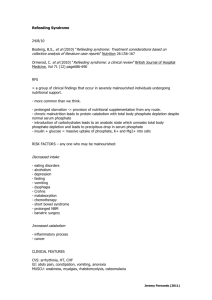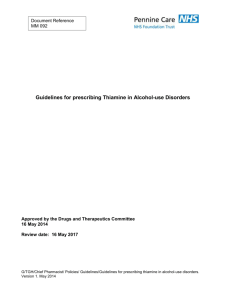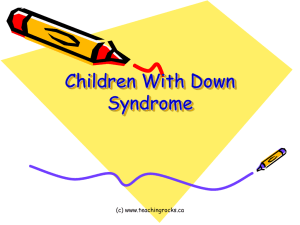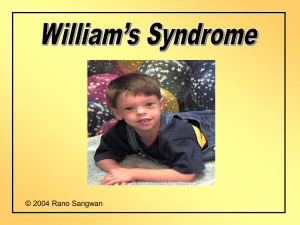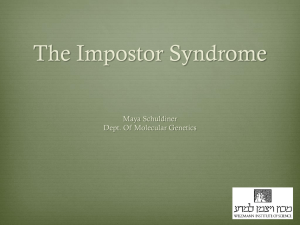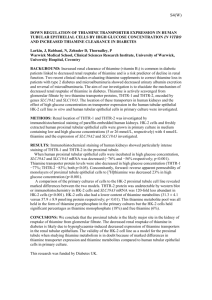Wernike-Korsakoff
advertisement
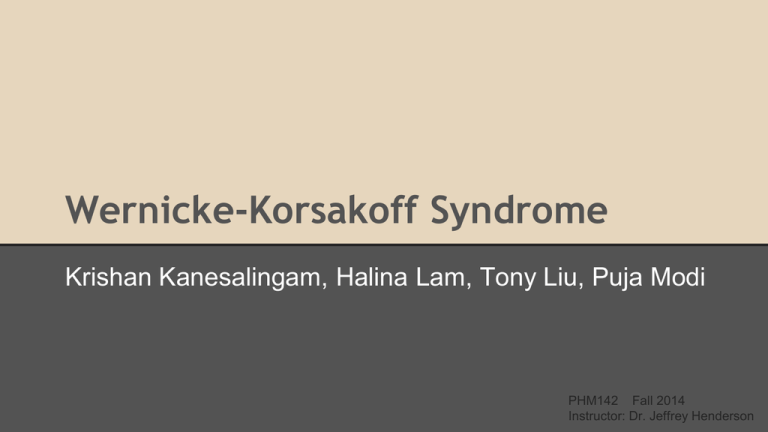
Wernicke-Korsakoff Syndrome Krishan Kanesalingam, Halina Lam, Tony Liu, Puja Modi PHM142 Fall 2014 Instructor: Dr. Jeffrey Henderson In this Presentation... ● Background information ● Causes ● Symptoms ● Biological significance of thiamine ● Relevant pathways ● Diagnosis ● Treatment ● Testing Background ● Also known as “wet brain” ● Combination of two diseases: Wernicke’s encephalopathy and Korsakoff’s syndrome ● Very close relationship ● Begins with Wernicke’s encephalopathy, if not properly treated quickly, lead to Korsakoff’s syndrome Causes ● Alcohol abuse/chronic alcoholism (Main cause) ● Thiamine (Vitamin B1) deficiency (Secondary cause to alcoholism) ● Malnutrition caused by dietary restriction or eating disorder ● Surgeries related to obesity including bariatric surgery and gastric bypass surgery Symptoms ● Anterograde amnesia (inability to form new memories) ● Memory loss ● Loss of muscle coordination ● Vision changes such as eyelid drooping, abnormal eye movements, double vision ● Hallucinations/confusion Wernicke’s Encephalopathy ● Damage to central nervous system tissue ● Characterized by paralysis of the eye muscles, lack of muscle coordination, and confusion ● Various other effects occur depending on the area of the lesion (hypothalamus temperature regulation, medulla - ataxia) Korsakoff’s Syndrome ● Characterized by amnesia, creation of new memories, apathy ● Both of these diseases are caused by vitamin B1 (thiamine) deficiencies, simultaneous occurrence makes wernicke-korsakoff disorder Biological Significance of Thiamine ● Convert carbohydrates into glucose (sugar) for energy; important for intense physical activity ● Breakdown of fats and proteins ● AKA vitamin B1, B complex vitamins maintain muscle tone along the walls of digestive tract ● Promotes the health of the nervous system, skin, hair, eyes, mouth and liver ● “anti-stress” Relevant Pathways ● Transketolase requires thiamine as a cofactor → Defense against oxidative stress ● NADPH is crucial in the elimination of H2O2 Relevant Pathways ● Pyruvate dehydrogenase uses thiamine as a cofactor ● Pyruvate → Acetyl CoA after glycolysis ● Also necessary for the citric acid cycle; alpha ketoglutarate dehydrogenase needs thiamine as a cofactor to catalyze alpha-ketoglutarate → succinyl CoA ● Important for myelin synthesis and neurotransmitter regulation ● In general, thiamine is extremely important for energy production in the body Relevant Pathways Diagnosis ● WKS is often missed as a diagnosis ● Acute phase physical examination ● Nutritional testing should be done ● Full medical history necessary ● Diagnostic imaging may help Testing for the Syndrome Several simple examinations can be performed, most of which are of the nervous/muscular systems and are used to check the damage done to the nerve system. ● ● ● ● ● ● ● ● ● ● ● abnormal eye movement decreased or abnormal reflexes fast pulse low blood pressure low body temperature muscle weakness and atrophy problems with walking (gait), coordination and balance ( ataxia) skin changes red “beefy” tongue poor eating habits or eating disorders drowsiness or confusion Testing for the Syndrome There are multiple nutritional tests that may be done. A few of them are: ● Serum albumin = LOW ● LFTs ● Serum Vitamin B1 Tests = LOW ● Transketolase (enzyme) activity in the RBCs = LOW ● Pyruvate Levels testing = HIGH ● Serum of urine alcohol level testing Diagnostic imaging tests for WKS include: ● Electrocardiograph (ECG) ● Computed Tomography (CT) ● Magnetic Resonance Imaging (MRI) Recently there has been a testing discovery of genetic marker APOE4 which is being used for WKS. Treatment WKS treatment should begin immediately and initially treatment may involve hospitalization. There are 3 types: ➢ Nutritional ○ ➢ balanced diet with vitamin B1 Medicational ○ intravenous vitamin B1 ○ oral vitamin B1 In some cases treatment of vitamin B1 deficiency an adverse reaction may occur. ➢ Psychological/Social ○ alcoholism (withdrawal sympotms , quitting) ○ brain damage Summary Slide ● This illness is a combination of Wernicke’s encephalopathy and Korsakoff syndrome. ● Number one cause: alcohol abuse/chronic alcoholism, thiamine deficiency is also a major cause ● Common symptoms: Confusion, loss of memories, loss of muscle coordination, hallucinations and vision problems. ● A diagnosis involves physical examinations and nutritional testing. Medical history and diagnostic imaging may be used additionally. ● Treatment involves having a balanced diet, taking vitamin B1 supplements and receiving psychological aid where necessary. ● Thiamine is important for converting carbohydrates into glucose (sugar) for energy, breakdown of fats and proteins, maintaining muscle tone along the walls of digestive tract, promoting the health of the nervous system, skin, hair, eyes, mouth and liver ● Thiamine is needed as a cofactor of transketolase to make NADPH for maintenance of oxidative stress ● Pyruvate dehydrogenase uses thiamine as a cofactor to make acetyl CoA after glycolysis ● Alpha ketoglutarate dehydrogenase needs thiamine as a cofactor to creat succinyl CoA from alpha-ketoglutarate in the citric acid cycle Works Cited "Korsakoff Syndrome." Alzheimer's Disease and Dementia. Web. 25 Nov. 2014. http://www.alz.org/dementia/wernicke-korsakoff-syndromesymptoms.asp “Korsakoff's Syndrome” Korsakoff's Syndrome - Neurobiology Of Disease 07. Web. 25 Nov. 2014. https://sites.google.com/a/conncoll.edu/neurobiology-of-disease-07/home/korsakoffs-syndrome#TOC-Causes Nunes, G.D.F., Y. Poitelon, E. Hurley, M. Patel, K.A. Nave, L. Wrabetz, and M.L. Feltri. "Metabolic Crosstalk between Neurons and Myelinating Cells: A Means to Keep Axons Functional at Distance from the Neuronal Cell Body?" CURCA: Center for Undergraduate Research and Creative Activities. University of Buffalo, The State University of New York. Web. 25 Nov. 2014. http://curca.buffalo.edu/students/pdfs/2013_posters/NunesGustavo.pdf "Wernicke-Korsakoff Syndrome | Doctor | Patient.co.uk." Patient.co.uk. Web. 25 Nov. 2014. http://www.patient.co.uk/doctor/wernicke-korsakoffsyndrome# "Wernicke-Korsakoff Syndrome." Family Caregiver Alliance. Web. 25 Nov. 2014. https://www.caregiver.org/wernicke-korsakoff-syndrome “Wernicke-Korsakoff Syndrome”. Judith Brown CPD. Web. 25 Nov. 2014. http://www.judithbrowncpd.co.uk/Wernicke.pdf "Wernicke-Korsakoff Syndrome: MedlinePlus Medical Encyclopedia." U.S National Library of Medicine. U.S. National Library of Medicine. Web. 25 Nov. 2014. http://www.nlm.nih.gov/medlineplus/ency/article/000771.htm "Wernicke-Korsakoff Syndrome." : Risk Factors, Causes & Symptoms. Web. 25 Nov. 2014. http://www.healthline.com/health/wernicke-korsakoffsyndrome#Overview1 "Wernicke-Korsakoff Syndrome ."Wernicke-Korsakoff Syndrome. Web. 25 Nov. 2014. http://emedicine.medscape.com/article/288379-overview#a0104

